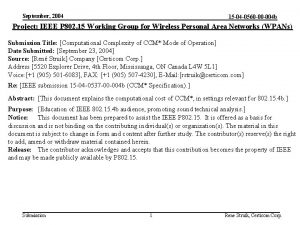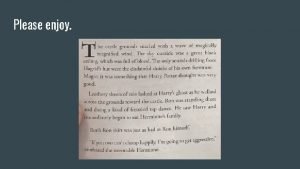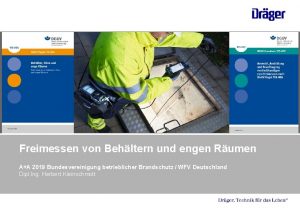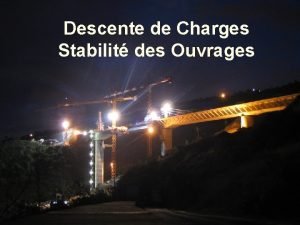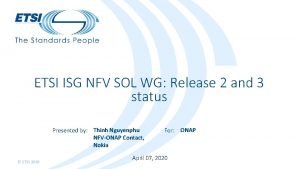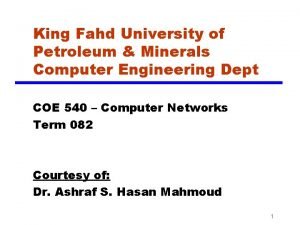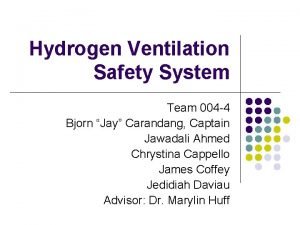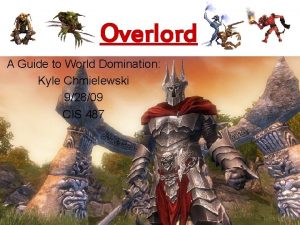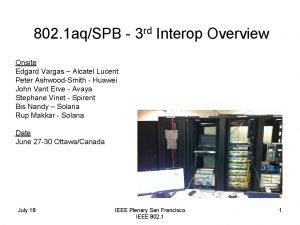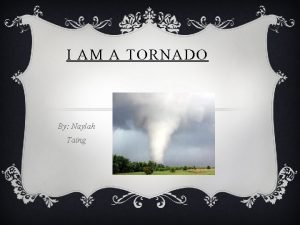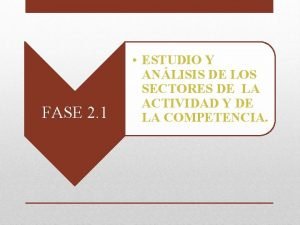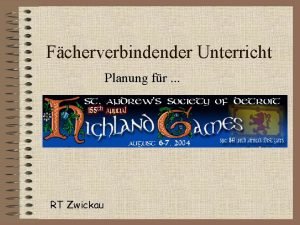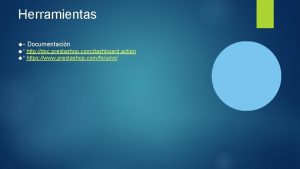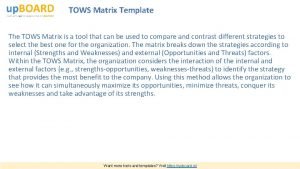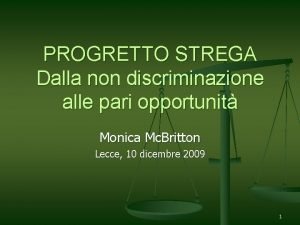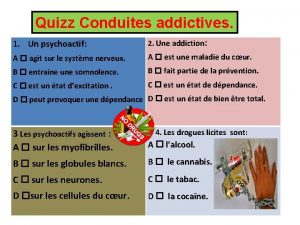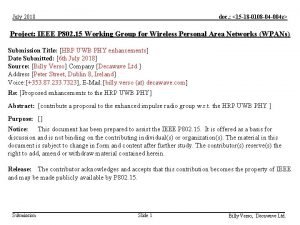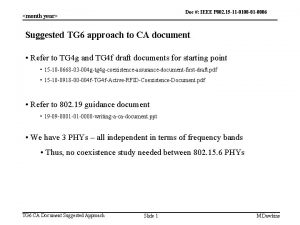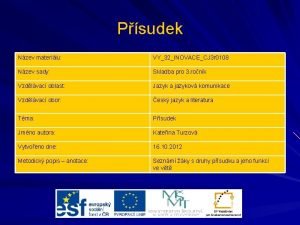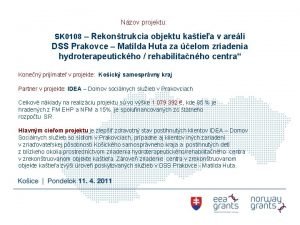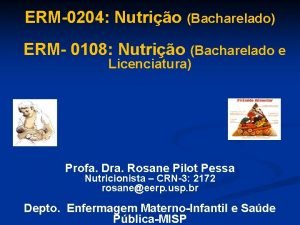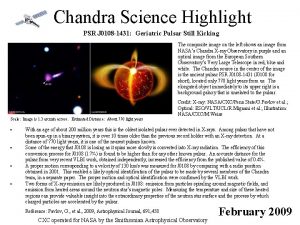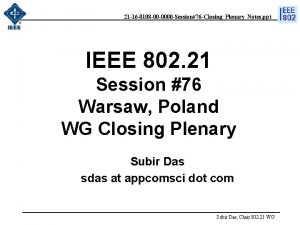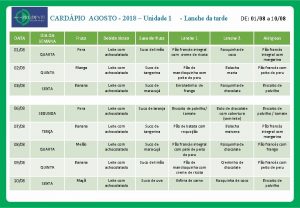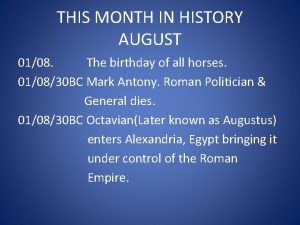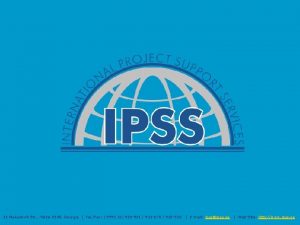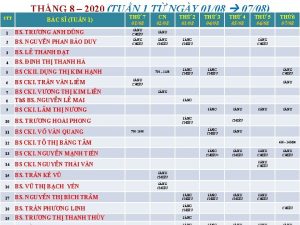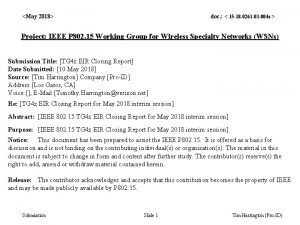doc 15 18 0108 01 004 z May




















- Slides: 20

doc. : <15 -18 -0108 -01 -004 z> May 2018 Project: IEEE P 802. 15 Working Group for Wireless Personal Area Networks (WPANs) Submission Title: [HRP UWB PHY enhancements] Date Submitted: [9 th May 2018] Source: [Billy Verso] Company [Decawave Ltd. ] Address [Peter Street, Dublin 8, Ireland] Voice: [+353. 87. 233. 7323], E-Mail: [billy. verso (at) decawave. com] Re: [Proposed enhancements to the HRP UWB PHY] Abstract: [contribute a proposal to the enhanced impulse radio group w. r. t. the HRP UWB PHY ] Purpose: [] Notice: This document has been prepared to assist the IEEE P 802. 15. It is offered as a basis for discussion and is not binding on the contributing individual(s) or organization(s). The material in this document is subject to change in form and content after further study. The contributor(s) reserve(s) the right to add, amend or withdraw material contained herein. Release: The contributor acknowledges and accepts that this contribution becomes the property of IEEE and may be made publicly available by P 802. 15. Submission Slide 1 Billy Verso, Decawave Ltd.

doc. : <15 -18 -0108 -01 -004 z> May 2018 The aim of this presentation: Outline a set of enhancements to the HRP UWB PHY which will result in: • Improved ranging timestamp integrity and robustness • Reduced on-air transmission times: – This will increase channel capacity and reduce power consumption Also, outline MAC enhancements to reduce the number of messages to complete a two-way ranging time-of-flight (TOF) measurement: • Shortens the time to complete a TOF measurement: – Also increases channel capacity and reduces power consumption Submission Slide 2 Billy Verso, Decawave Ltd.

doc. : <15 -18 -0108 -01 -004 z> May 2018 Timestamp integrity and robustness: • The HRP UWB PHY synchronisation sequence is made up of repeated symbols consisting of (ternary) Ipatov sequences with the property of perfect periodic autocorrelation. Accumulation of this correlation yields a channel impulse response (CIR) from which the first arriving ray (RX timestamp) can be determined. The problem: • Accidental or intentional interference from other transmitters of the same sequence, or repeated energy bursts at the preamble symbol rate, can give rise to artefacts in the CIR giving erroneous RX timestamp results. Submission Slide 3 Billy Verso, Decawave Ltd.

doc. : <15 -18 -0108 -01 -004 z> May 2018 Timestamp integrity and robustness: The solution: • Include a cryptographically generated pulse sequence in the transmitted PHY frame and have the receiver generate its own version of this sequence to cross correlate and accumulate to produce a CIR to get RX timestamp. • Since only valid transmitters and receivers know the key to generate this ciphered sequence it is secure against both accidental interference and intentional malicious attack neither of which will correlate correctly with the ciphered sequence. Submission Slide 4 Billy Verso, Decawave Ltd.

doc. : <15 -18 -0108 -01 -004 z> May 2018 Timestamp integrity and robustness: • Two modes to set where the ciphered sequence is placed in the frame • Mode 1 – After the SFD before PHR – Deterministic position without needing to adjust for varying data frames length. – Cipher CIR processing to get the RX timestamp can begin earlier • Mode 2 – After the data – Allows interworking with receivers expecting normal HRP UWB frame format – Data can be received without cipher alignment and used to regain alignment Submission Slide 5 Billy Verso, Decawave Ltd.

doc. : <15 -18 -0108 -01 -004 z> May 2018 Cipher sequence structure: • With the cipher sequence generated cryptographically it will only be correctly received (correctly correlated in the receiver) when both TX and RX parties know the keys and cryptographic scheme. • The receiver can validate the sequence by measuring the strength of the correlation across the whole sequence • To promote interworking between vendors the cryptographic scheme will be defined in the amendment – The proposed scheme is based on AES-128 in counter mode – This has a 128 -bit key and a 128 -bit nonce (generated via an LFSR) – The resultant sequence of 1’s and 0’s define the pulse polarity for the cipher sequence Submission Slide 6 Billy Verso, Decawave Ltd.

doc. : <15 -18 -0108 -01 -004 z> May 2018 Cipher sequence CSPRNG: • First of two options: Submission Slide 7 Billy Verso, Decawave Ltd.

doc. : <15 -18 -0108 -01 -004 z> May 2018 Cipher sequence CSPRNG: • Second of two options: Submission Slide 8 Billy Verso, Decawave Ltd.

doc. : <15 -18 -0108 -01 -004 z> May 2018 Cipher sequence LFSR: • 128 -bit LFSR: • 64 -bit LFSR: Submission Slide 9 Billy Verso, Decawave Ltd.

doc. : <15 -18 -0108 -01 -004 z> May 2018 Cipher sequence structure: • For 64 MHz PRF, the 64 bits of CSPRNG output are used to define 64 pulse polarities – i. e. 1 gives a positive polarity pulse, 0 gives negative polarity pulse • These are spread by the delta function δL of length L = 4 to create 256 chips at the peak PRF of 499. 2 MHz, and the symbol is completed with 256 zero chips. • The symbol time Tcsymb is ~1. 0256 µs (mean PRF 62. 4 MHz). • Cipher sequence length 32 symbols up to 2048, steps of 8. • In mode 2 a gap of 512 chips is inserted between the end of data and the start of the first cipher sequence symbol Submission Slide 10 Billy Verso, Decawave Ltd.

doc. : <15 -18 -0108 -01 -004 z> May 2018 Reduced on-air transmission times: • The frame duration is a critical parameter – Shorter frames save power since the radio can be turned off sooner – Send the PHR at the data rate for 6. 81 Mb/s and 27 Mb/s frames • Two-way ranging applications typically use fixed data rate and frame formats • Compress the preamble and SFD transmission phases – Reduce the spreading factor in the preamble sequences • The high peak PRF of the HRP UWB PHY affords this possibility – Use Ipatov codes with greater proportion of non-zero elements • Increases symbol energy to compensate for shorter symbols • Compress the PHR and data symbols for 27 Mb/s data rate – remove the burst time hopping and reduce the guard period duration – Use just BPSK to encode the data, (i. e. no BPM) – Use 8 pulses per burst instead of 2 • Increases multipath immunity for this 27 Mb/s data mode modulation Submission Slide 11 Billy Verso, Decawave Ltd.

doc. : <15 -18 -0108 -01 -004 z> May 2018 Compressed 27 Mb/s modulation mode • Using existing convolutional encoder (16. 3. 3. 2), use output g 0 to select 1 of 2 pulse sequences, and g 1 to invert or not. – This convolution code has maximum free distance (coding gain) and comes from Proakis, it is rate 1/8. • And scramble v(n) using the existing scrambler (16. 3. 2), giving 8 chips per burst and 8 chips guard interval. • This modulation is 6 d. B better than current HRP UWB PHY 27 Mb/s, – Same range as 6. 8 Mb/s in AWGN channel – Just 1 d. B worse than 6. 8 Mb/s in heavy multipath environments – Existing HRP UWB PHY Viterbi decoder can be reused, altering only the input metrics Submission Slide 12 Billy Verso, Decawave Ltd.

doc. : <15 -18 -0108 -01 -004 z> May 2018 Compressed preamble and SFD • Using length 31 Ipatov sequence with 25 pulses and 6 zeros • Spread by the delta function δL of length 4, (or for very high compression L = 1). • SFD [-1 -1 +1 -1 0 0] spread by the preamble symbol Submission Slide 13 Billy Verso, Decawave Ltd.

doc. : <15 -18 -0108 -01 -004 z> May 2018 Compressed cipher sequence • Reduce cipher sequence duration by removing most of the gaps (of 256 zero chips) • Compressed cipher symbols then have no gaps, just the spread sequence of 256 chips however 2 gaps are inserted for every 64 of these gapless cipher symbols. – Gaps of 256 zero chips are inserted before and after the 1 st symbol, after the 64 th and 65 th symbol, after the 128 th and 129 th symbol, etc. The resultant PRF is 124. 8 MHz peak and 121 MHz mean. Submission Slide 14 Billy Verso, Decawave Ltd.

doc. : <15 -18 -0108 -01 -004 z> May 2018 Compressed PHR • Reduce PHR duration by sending it at the data rate for 6. 81 Mb/s and 27 Mb/s frames. • We can make a new PHR. – pre-4 z PHY won’t be able to receive the PHR – Don’t need data rate bits, or SYNC length specifier – Can modify PHR to allow longer data frames at these higher rates to increase the utility of the standard. • Proposal: – 10 bit length gives 1023 max frame length. – GS bits to specify mode 2 data to cipher sequence gap. Submission Slide 15 Billy Verso, Decawave Ltd.

doc. : <15 -18 -0108 -01 -004 z> May 2018 MAC changes to support the previous items: New PIB attributes providing the API for the new features: Submission Slide 16 Billy Verso, Decawave Ltd.

doc. : <15 -18 -0108 -01 -004 z> May 2018 MAC enhancements for TOF measurement: • The current MAC provides ranging counters in the MCPSDATA primitives – This does not promote standardised TOF interworking – It leaves the messaging for TOF measurement to the upper layers – In general it is necessary to communicate response times or roundtrip delay times between the parties to complete the TOF calculation • The addition of Information Elements (IEs) by amendment 4 e provides a mechanism to standardise ranging messages • This also provides an opportunity improve the utility of the MAC such that it would be possible for a TOF estimate to be completed with just two messages, one TX and one RX – See next sheet Submission Slide 17 Billy Verso, Decawave Ltd.

doc. : <15 -18 -0108 -01 -004 z> May 2018 Ranging mechanism: SS-TWR • For single-sided two-way ranging between two devices, A and B, we need a transmitted message from A and a response from B – The response could be an ACK generated by the MAC or a data frame sent under upper layer control. • For device A to calculate the estimated time of flight, Tprop, device B needs to communicate its reply time, Treply, to device A. – This could be done in a subsequent frame, but as a further enhancement we should include the option for the MAC to be able to pre-compute, Treply, and include it in an IE embedded in the reply message, Submission Slide 18 Billy Verso, Decawave Ltd.

doc. : <15 -18 -0108 -01 -004 z> May 2018 Specifying the IEs for TOF measurement: • This may seem like a lot of work, but it is not, since a model for this already exists…. • All the necessary IE and mechanisms (and the text) for what is needed have already been developed and included in the recently published IEEE 802. 15. 8 -2017 standard • The proposal here is to copy the relevant text relating to ranging and IE’s from that standard • The only change needed is re-numbering the IEs – The 802. 15. 8 IEs for ranging will need to be merged into the 802. 15. 4 IE table which should be a small task Submission Slide 19 Billy Verso, Decawave Ltd.

doc. : <15 -18 -0108 -01 -004 z> May 2018 THE END Submission Slide 20 Billy Verso, Decawave Ltd.
 Auec2-001
Auec2-001 0560 004
0560 004 700-004 vt
700-004 vt Wer darf behälter freimessen?
Wer darf behälter freimessen? Croix de saint andré charpente métallique
Croix de saint andré charpente métallique Sol 004
Sol 004 Pyp 004 kfupm
Pyp 004 kfupm Team-004
Team-004 Hci patterns may or may not include code for implementation
Hci patterns may or may not include code for implementation Overlord open an ai doc first
Overlord open an ai doc first Doc 9303-3
Doc 9303-3 My peolple doc
My peolple doc Ges doc
Ges doc Slide to doc.com
Slide to doc.com Www.menti.comandusecode
Www.menti.comandusecode Computer doc zwickau
Computer doc zwickau Mercantil prestashop
Mercantil prestashop Tows analysis template
Tows analysis template Lodwick klassifikation
Lodwick klassifikation Slide to doc.com
Slide to doc.com Doc psychoactif
Doc psychoactif

